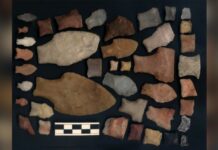A tantalizing mystery is unfolding at Egypt’s iconic Giza plateau, where an unusual discovery in the Pyramid of Menkaure suggests a possible hidden entrance. This intriguing possibility stems from two distinct voids detected on the eastern face of the pyramid during recent scans by researchers.
The Pyramid of Menkaure, built around 2490 BC during the reign of Pharaoh Menkaure, is the smallest and last of the three main pyramids erected at Giza. It’s notable for its polished stonework, particularly on the eastern face where a smooth patch of four-by-six meter section stands out — puzzling researchers because there appears to be no corresponding doorway.
Independent scholar Stijn van den Hoven first floated the idea in 2019 that this polished area might conceal an additional entrance. A collaborative team from Cairo University and the Technical University of Munich, part of the Scan Pyramids project, decided to investigate his theory using cutting-edge non-invasive techniques. These included electrical resistivity testing (measuring resistance to electric currents), ground penetrating radar (using radio waves to map subsurface structures), and ultrasonic testing (employing sound waves to analyze internal features).
The combined data from these methods revealed two closely positioned voids behind the eastern face of the pyramid. One lies about 1.4 meters, while the other is roughly 1.13 meters back from its surface. While this finding lends credence to van den Hoven’s proposal, researchers stress that further examination and more extensive data gathering are crucial to definitively determine the nature of these voids.
“This is a very interesting discovery,” says Peter Der Manuelian, an Egyptology professor at Harvard University who wasn’t involved in the research, “and shows we still have much to learn about the Pyramids at Giza.” He points out that most Old Kingdom pyramids (circa 2649 to 2150 BC), including those at Giza, typically feature entrances on their northern faces. “Further exploration will hopefully reveal more about the significance of these voids—whether they are construction anomalies, part of a secondary entrance, or something else entirely,” Der Manuelian adds.
This ongoing investigation continues to deepen our understanding of these enigmatic ancient structures, highlighting that even after millennia, the Giza pyramids continue to yield secrets waiting to be uncovered.







































































